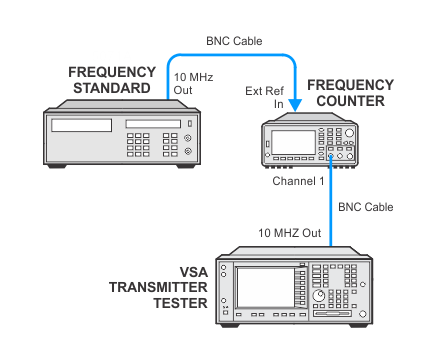
This test requires a minimum warmup time of 24 hours. The DUT must be turned on (that is, not on standby) for the entire warmup period.
|
|
This test requires a minimum warmup time of 24 hours. The DUT must be turned on (that is, not on standby) for the entire warmup period. |
The Frequency Reference Accuracy test verifies that the internal frequency reference of the instrument is functional within the guideline set for frequency drift. If the reference frequency has exceeded the guideline limits, a recommendation is made in the test report to make the appropriate adjustment.
For this test, a frequency counter is stabilized using an external frequency standard. The 10 MHz internal reference frequency is read using the stabilized frequency counter.
The frequency reference should remain within its attained aging rate if the instrument is left on, the instrument orientation with respect to the earth's magnetic field is maintained, and the instrument does not sustain any mechanical shock. Frequency changes due to orientation with respect to the earth's magnetic field and altitude changes will usually be nullified when the instrument is returned to its original position. Frequency changes due to mechanical shock will usually appear as a fixed frequency error.
The internal frequency reference is also sensitive to temperature change. The best frequency drift performance will be at ambient temperatures of 20° C to 30° C.
Placing the analyzer in STANDBY mode turns the frequency reference oscillator off, while continuing to provide power for the frequency reference oven. Keeping the oscillator warm helps minimize warmup time. However, the frequency reference oscillator must be on to attain its aging rate.
Click here for troubleshooting.
Related adjustments: Frequency Reference Adjustment
|
Test Equipment |
Recommended Model Number |
|---|---|
|
Frequency counter |
53230A |
|
Frequency standard |
Microsemi 5071A |
|
Cable, BNC |
8120-2582 |

